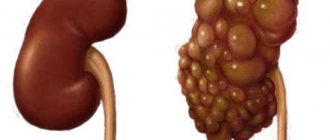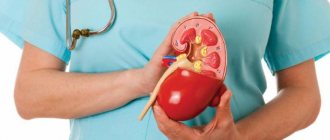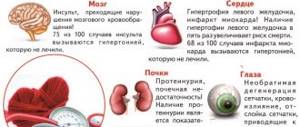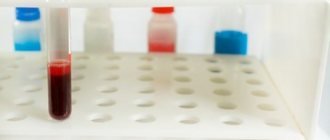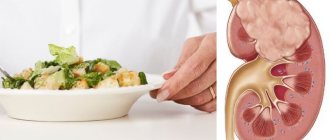An effective method of normalizing the metabolism of amino acids and proteins in the body is a diet with increased creatinine. The substance creatine is an important indicator of kidney function and the process of energy formation in muscles. It is formed during the reaction of the cleavage of a phosphorus residue from ATP (adenosine triphosphoric acid) molecules, accompanied by the release of vital energy, which is spent on the work of the muscles of the whole body. Creatinine is excreted by the kidneys as an end product of metabolism.
What are creatinine and urea
Creatinine is a substance that appears as a result of the breakdown of creatine phosphate. The level of this substance in the blood can be determined using a biochemical blood test. For a more complete clinical picture, a urine test is often also necessary. Creatinine is the main indicator that reports on the condition of the kidneys.
Urea is released during the breakdown of nitrogenous compounds in the body. An increase in urea often goes “hand in hand” with an off-scale creatinine reading. This is the second most important indicator, an increase in which indicates serious problems with the organs of the urinary system.
Physical fatigue and creatinine levels
Since creatinine levels are directly affected by creatine - an amino acid that is produced during active muscle work - it becomes obvious that the indicators are in close interaction.
If you take a biochemical blood test the next day after a heavy strength training, the values may deviate by 10-30 units from the norm. Most often they are overestimated, but depending on the individual characteristics of the organism they can be underestimated. Before taking a biochemical blood test, it is optimal to avoid physical fatigue for two to three days. This is the only way to get reliable results. On the day of the test, it is not advisable to eat heavy food, drink sugary drinks, smoke or take long walks. The best thing to do is to be calm, rested and fresh.
What do these indicators in a blood test indicate?
An increase in creatinine and urea most often indicates either severe protein intoxication or the development of chronic renal failure. Sometimes such a clinical picture develops with acute pyelonephritis or glomerulonephritis.
Elevated creatinine may also indicate the following diseases and conditions:
- radiation sickness;
- hyperthyroidism;
- myocardial infarction;
- ammonia poisoning;
- physical fatigue at the time of donating blood.
You should not hesitate to hospitalize if your creatinine level has risen above one hundred units. Lack of adequate treatment can cost the patient his life.
How to reduce urea in the blood? - Diagnostics
Some of the main blood indicators are creatinine and urea .
Creatinine levels play a huge role in patients with kidney failure. Urea is the end product of protein metabolism. Its main function: neutralization of ammonia. Its level in the blood and rate of elimination indicate the proper functioning of the kidneys.
How to reduce creatinine and urea using folk remedies?
What is creatinine?
Creatinine is a substance that is formed as a result of residual protein metabolism . With ammonia, non-protein nitrogen compounds, urea is responsible for the creation of residual nitrogen.
Creatinine is excreted by the kidneys. Any changes in the process indicate pathology of the urinary system. The norm depends on the level of development and accumulation of muscle mass in the body.
In the elderly, an increase in creatinine is usually accompanied by muscle atrophy. When diagnosing, it is necessary to take into account the age group of the patient. Healthy men have higher creatinine levels than women. The indicator is measured in the number of dissolved micromoles per liter of blood (µmol/l).
Blood tests are taken in the morning on an empty stomach. This is a must. When protein is consumed, muscle activity becomes full, which will affect the objectivity of the tests.
Causes of elevated creatinine:
- injuries or illnesses that have caused severe damage to muscle tissue;
- dehydration;
- disturbances in the urinary tract, their blockage;
- intestinal obstruction;
- kidney diseases;
- abuse of fish and meat dishes, as they contain many toxins that enter the blood and cause an increase in creatinine;
- taking medications;
- excessive physical activity, overwork or unusual stress.
Factors contributing to increased creatinine:
- a sharp decrease in muscle mass due to prolonged fasting;
- first and second trimesters of pregnancy;
- vegetarianism;
- dystrophic changes in muscle mass;
- hyperhydria;
- taking corticosteroids;
- heavy internal bleeding due to neoplasms and ulcers activates the synthesis of creatinine.
An increase in creatinine in renal failure can also occur with other destructive processes:
- injury, prolonged compression of tissue;
- the operation performed;
- extensive burn;
- decaying neoplasm;
- necrosis of the heart muscles (this can happen with myocardial infarction);
- excessive bleeding, diarrhea, vomiting provoke a large loss of fluid.
In the chronic form, symptoms increase gradually: headache, general body aches, and nausea appear.
What else is dangerous about elevated creatinine:
- There will be pain in the back.
- Diuresis will be impaired due to incomplete excretion of urine.
- Blood pressure will increase.
- Protein and red blood cells will be found in the urine.
- Consciousness will become confused and convulsions will appear.
- A person may lose appetite, experience shortness of breath, nausea, and anemia.
What is urea?
Urea is a compound in the body that is formed as a result of the breakdown of various proteins . The kidneys must remove it from the body. An increase in urea levels indicates that the kidneys are not coping with their functions.
Causes of pathology:
- kidney diseases (urolithiasis, nephrosis, renal failure and others);
- intestinal infections (cholera, salmonellosis and others);
- blood diseases (leukemia, leukemia, hepatitis);
- heart disease (heart failure and others);
- diseases of the muscular system;
- burns;
- trauma, septic shock;
- taking medications;
- excessive physical activity;
- abuse of protein foods;
- diabetes.
Due to impaired filtration function of the kidneys, urea can return to the body and accumulate in the blood. The content of ammonia, creatinine, acetone and other substances toxic to the body will also increase.
Without a blood test, urea levels cannot be determined. Symptoms of waste accumulation will be accompanied by fatigue, headaches, weakness, and increased fatigue.
If you start this process, other symptoms will appear:
- swelling;
- muscle pain;
- decrease or increase in urine output;
- increased sweating;
- malfunction of the gastrointestinal tract (diarrhea, vomiting, nausea);
- decreased visual acuity.
If urea is not excreted in the urine, urea and nitrogenous compounds will leak through the skin. The “uremic frost” will begin . White patches will appear on the face, nostrils and neck.
In case of chronic kidney disorders, it is very difficult to reduce the concentration of urea. Conservative methods help if there is no serious disease.
Elevated levels of urea can lead to disturbances in the functioning of the brain and central nervous system.
The following traditional medicine recipes will help lower creatinine in the blood:
- Taking diuretic drinks . This is a simple and effective method that reduces high creatinine levels. Drink two large cups of tea a day. Herbal teas can stimulate kidney function, increase urine output, and reduce creatinine. Can be purchased at pharmacies.
- Nettle leaves are brewed separately or together with calendula flowers and knotweed . Pour two tablespoons of the mixture into a glass of boiling water. Leave for an hour in a thermos and filter. Drink half a glass a day.
- Sage contains lithospermate, which improves kidney function and accelerates the release of creatinine from the body. Mix sage root, burdock, dandelion leaves, and birch bark in equal proportions. Brew three tablespoons with a glass of boiling water. Strain the drink and drink three tablespoons before bed.
- Pour 60 g of lingonberry leaves into a glass of hot water and place the container in a water bath for half an hour. Allow the boiling water to cool, drink a third of a glass three times a day. The leaves can also be brewed with chamomile, motherwort, violet flowers, string, and dandelions. Drink three tablespoons before bed.
- Rosehip leaves and berries are brewed in equal proportions with hawthorn leaves, dill seeds, bay leaves and parsley root . Pour two dessert spoons of the mixture into a glass of boiling water and leave for three hours or overnight. Take the drink 5 tablespoons seven times a day.
- Rosehip leaves and pomegranate peels are poured into a thermos, poured 500 ml of boiling water, left for half an hour, filtered, and drunk throughout the day.
- A tablespoon of dandelion root is mixed with flowers of violet, celandine, St. John's wort . The mixture is poured with half a liter of water, brought to a boil, and the drink is infused in a warm place for an hour. Strain the tea, drink a quarter glass three times a day, half an hour before meals for one month.
- Pour two teaspoons of chamomile and mint into a glass of cool water , bring to a boil in a water bath, leave for 40 minutes, filter, drink half a glass in the morning and evening.
- Two tablespoons of oak bark and bearberry herb are poured into a glass of water, the mixture is brought to a boil, filtered and taken 6 tablespoons several times a day.
- Mix birch bark and buds, oak bark . Pour 4 tablespoons of the mixture into a liter of water and boil for an hour over low heat. Infuse and let cool, strain. Drink half a glass six times a day.
Contraindications:
- pregnancy (especially during pregnancy, you should not take sage, which can cause a miscarriage);
- lactation;
- breast and uterine cancer;
- hypertension;
- acute kidney diseases.
How to lower creatinine in kidney failure with nutrition?
Diet to reduce creatinine
You need to drink one and a half or two liters of water a day . Excess fluid will lead to increased stress on the kidneys.
A breakfast of boiled rice will help reduce creatinine . Six tablespoons of rice are poured with cool water.
The liquid should cover the grains by two fingers. The rice is left to swell overnight, boiled in the morning, and eaten without oil or salt.
Basic Rules:
- Limit protein foods (animal products). Protein cannot be completely eliminated.
- Reduce salt and potassium in your diet. Potassium can accumulate in the body, and the excretory system will not remove it in the required quantities. The ability of salt to retain fluid provokes an increase in blood pressure. The maximum daily salt intake is 2-3 g.
Eliminate completely:
- fat meat;
- fatty fish;
- full fat milk;
- yeast bread and pastries;
- fried foods;
- smoked meats;
- spicy dishes;
- spices, sugar, salt.
Limit:
- dietary meat;
- chicken eggs (you can afford up to three per week);
- fish.
It is necessary to exclude all nutritional supplements that contain creatinine from the diet. This is especially true for athletes.
Reduced urea levels
How to lower blood urea at home using diet and folk remedies? The level of urea in the blood, like the level of creatinine, is reduced using traditional medicine only after the approval of doctors.
The main emphasis is on diuretic teas made from rose hips, black currants, parsley roots, St. John's wort, linden, black elderberry, juniper, corn silk, and cornflower flowers.
Recipes for other remedies:
- two tablespoons of licorice root for 10 minutes over low heat and let it brew. Drink half a glass three times a day.
- Two tablespoons of bearberry are poured into a glass of boiling water, boiled in a water bath, filtered, and drunk two tablespoons 20 minutes before meals.
- Dandelion root, wheatgrass, goldenrod, black currant leaf are mixed, poured with boiling water, and simmered over low heat. Drink the decoction three times a day for a month.
- Simmer hernia grass, horsetail, and steelhead root over low heat, cool, strain the broth and drink three times a day half an hour before meals. Should not be taken if you have urinary tract inflammation.
- two to three glasses of mineral water with lemon juice per day for 10 days. Sugar should not be added.
- Lemon zest is mixed with honey in equal proportions and put in the refrigerator. Drink two tablespoons with tea.
Diet
Cherries, celery, apples, lemons, nettles, cocktails of fruits and herbs (you can use home-grown salads, arugula, chard, spinach, parsley, nettles, horsetail, mint, coriander, apples, apricots, bananas, mangoes, pears, grapes, avocados, melons, berries), Brussels sprouts, sorrel, asparagus.
You should avoid overeating, fasting, and thirst . You need to give up tobacco and alcohol.
By-products, fatty meat and fish, peas, lentils, beans, yeast should be avoided.
You can replenish your body with protein through dairy products. You need to drink two liters of fluid a day, but do not put too much strain on your kidneys.
To normalize the level of creatinine and urea in the blood, you need to drink enough fluids, use diuretics that will facilitate the good removal of these substances from the body, and adhere to proper nutrition.
How to reduce urea in the blood in case of kidney failure - All about hypertension
Have you been struggling with HYPERTENSION for many years without success?
Head of the Institute: “You will be amazed at how easy it is to cure hypertension by taking it every day...
Read more "
Urea or urea or carbonic acid diamide is what ultimately remains of proteins after they break down.
Many people confuse urea with uric acid (the result of purine metabolism) and, it should be noted, they have something related, for example, they both belong to the group of residual nitrogen components, but in clinical laboratory diagnostics these indicators carry different concepts and cannot be considered as one whole.
Source: https://zdoroviecrimea.ru/kletki/kak-snizit-mochevinu-v-krovi.html
What is chronic renal failure
This is a condition in which the kidneys lose their functionality. As a result, the body finds itself in conditions of severe intoxication. This condition should not be underestimated: if no treatment measures are taken, the patient will die after a few days.
In parallel with the increase in creatinine and urea levels, the following occurs. The patient experiences surges in blood pressure, severe muscle weakness, lack of normal urination, and dizziness. A person cannot work and lead a normal lifestyle. He should immediately go to the nephrology department for an accurate diagnosis.
Symptoms of high creatinine in adults
A significant increase in creatinine indicates a malfunction of the urinary system, first of all, so the most common symptoms look like this:
- nagging pain in the lower back;
- tissue pastiness;
- urinary retention;
- blood pressure surges;
- convulsive syndrome;
- myalgia;
- chronic fatigue syndrome;
- nausea;
- memory loss,
- indifference to what is happening around.
A creatinine test alone is not enough to make a correct diagnosis. A significant excess of the norm is accompanied by an increase in other blood parameters, therefore additional testing is carried out, which determines the excretion of albumin in urine, the level of daily catecholamines, urea clearance, bilirubin, and the number of red blood cells.
Methods of therapy for chronic renal failure
Today, modern medicine offers only two ways to solve the problem: kidney transplantation or hemodialysis (the process of artificial blood purification).
Both of these methods also involve the patient being on a diet. With elevated creatinine, this is a necessary condition. Follow all the rules of therapeutic nutrition in order to remain sufficiently efficient and not suffer from constant weakness, pressure surges and dizziness.
So, if creatinine is elevated, what diet will help normalize the condition? It is worth noting that the scheme of proper nutrition for this disease has been developed quite a long time ago.
The basic principles of the diet for renal failure and elevated creatinine are prescribed in “table No. 7” according to Pevzner. Any nephrologist will inform his patient about the need to strictly adhere to the rules of this diet for the rest of his life. Even if a kidney is transplanted and the sick person’s condition stabilizes, he will still have to stop eating certain foods and drinks once and for all.
Basic principles of nutrition
Contrary to popular misconception, the therapeutic diet is not intended to worsen the patient’s life, but to accelerate the normalization of the condition. The diet for kidney failure is based on the following points:
- Diet: 4-5 times a day. You cannot take long gaps between meals. The day starts with breakfast.
- When hunger occurs, it is recommended to eat light snacks (fruits, baked vegetables, biscuits, yogurt).
- The water regime is maintained through freshly squeezed juices, fruit drinks, drinking yoghurts and non-carbonated mineral drinks. Requirement - volume of urine excreted in ml/day (diuresis) + 0.4-0.5 l.
- Food is prepared using gentle methods: boiling, steaming, baking in the oven.
- The temperature of food consumed is moderate.
- To prevent your diet from becoming a burden, remember 4 simple rules when choosing food: variety, compliance with energy needs (calorie content), moderation (do not overeat) and simplicity (homemade food is recommended).
- Follow the ratio of proteins, fats and carbohydrates indicated by your doctor (according to the stage of renal failure, creatinine level and glomerular filtration rate).
- Avoid complex factory products with unclear composition and large amounts of extractive substances (spices, smoked meats, food additives, dyes) and preservatives.
- Limit your salt intake. It can be replaced with natural seasonings (herbs, lemon juice, high-quality soy sauce).
Not all kidney diseases limit the consumption of animal proteins, which should be discussed with your doctor. Often they need to be increased in the diet due to increasing exhaustion.
| Stage of renal failure (based on glomerular filtration rate in ml/min/1.73 m2) | Daily energy requirement (kcal/kg) | Na in mg | Proteins (g/kg body weight) |
| I-II Art. | 35 (if age 60-65 years) | 1840-2300 | 0,8-1 |
| III-IV Art. | is the same | 2300-2760 | 0,8-1 |
| V Art. (hemodialysis) | 25-30 (at normal weight) + infusion nutrient solutions | 1840-2300 | 1-1.3, but before dialysis - a strict low-protein diet |
Basic principles of a therapeutic diet
Following a diet with elevated blood creatinine should be based on several fundamental principles:
- The main condition is limiting protein of animal and plant origin. The daily diet should contain no more than 60 grams of the nutrient. The basis of nutrition should be carbohydrates. Proteins are highly toxic to the kidneys and create unnecessary stress on the urinary system.
- If the patient has previously been involved in weightlifting and took high-protein supplements, then he will have to give up his hobby. Taking protein shakes on a diet with elevated creatinine is prohibited.
- Adequate drinking regime is an important condition for good health with elevated creatinine. The amount of liquid (pure water) per day should ideally be 30 ml per 1 kg of weight. In this case, liquid from first courses, borscht, soups, milk, kefir, coffee and tea is not taken into account. If it is difficult to drink such an amount, then at least you should drink at least one and a half liters of clean water.
- If an increase in creatinine is accompanied by surges in blood pressure and dizziness, you should almost completely avoid salt. If there are no such problems, then you should simply avoid salty and spicy dishes and foods. Of course, it is prohibited to eat chips, salty crackers, fish and other similar products.
- A common mistake is to completely cut protein from your diet. This is a real blow to the body. You should buy a kitchen scale and weigh each piece of meat or fish. Now you will have to constantly calculate the amount of nutrients in your diet. This rule will help you feel great and regain your former performance.
What do low creatinine levels mean?
Reduced creatinine in the blood of women indicates a violation of metabolic processes in the body. Often, indicators below 50 units are accompanied by exhaustion, loss of consciousness, muscle atrophy, and low performance. In women, this indicator may indicate anemia (cobalamin or iron deficiency), anorexia or severe exhaustion - these are the most common causes.
Is blood creatinine low in men? This indicates poor nutrition, substance abuse, and severe exhaustion. In order to return indicators to normal values, you should eat right and lead a healthy lifestyle. In some cases, it is necessary to take special medications (if necessary, they will be prescribed by an endocrinologist or nephrologist).
Reduced creatinine in the blood of a child is observed with a deficiency of protein in the diet, with long-term use of drugs with glucocorticosteroids, with heart defects, and diabetes mellitus.
Sample menu for the week
The example menu below is neutral; you can rearrange dishes and change meal times if desired. This is just a kind of diet pattern for elevated creatinine in the blood and urea in women and men.
- Monday: vegetable stew, the white of one chicken egg, a pack of low-fat cottage cheese, lean borscht without meat, a package of diet bread made from whole grain or rye flour, pancakes made from whole grain flour without added fat, a couple of oranges or other citrus fruits, oatmeal with dried fruits.
- Tuesday: buckwheat porridge with skim milk, two apples, vegetable salad dressed with vegetable oil, pureed vegetable soup, cottage cheese casserole with whole grain flour.
- Wednesday: oatmeal with dried fruits, a pack of low-fat cottage cheese, pilaf with chicken fillet, a glass of kefir, an apple with cinnamon, baked in the oven, seafood salad with vegetable oil.
- Thursday: diet omelette with tomato and herbs, lean borscht, vegetable stew, celery smoothie, glass of kefir, grilled mackerel.
- Friday: buckwheat porridge with skim milk, a package of dietary bread made from whole grain or rye flour, salad dressed with vegetable oil, pureed vegetable soup, rice porridge with dried fruits; a piece of grilled fish fillet.
- Saturday: a handful of your favorite nuts (no more than 50 grams), pureed vegetable soup, cottage cheese casserole with whole grain flour, one boiled chicken egg, vegetable stew, a glass of kefir.
- Sunday: diet omelette with cauliflower and broccoli, lean borscht, cucumber salad with vegetable oil, fruit smoothie, apple with cinnamon, baked in the oven, a glass of fermented baked milk.
Principles of therapeutic nutrition
The level of creatinine is directly proportional to the quality of food and the amount of protein and amino acids in it. If creatinine is low in women, then protein should be added to the diet. To do this you need to consume the following products:
Of course, protein is found in cereals and even baked goods. But only in the products on the list is it easily digestible. For example, both a chicken egg and white bread (if you take both products in an amount of 100 grams) contain almost the same amount of protein. But it will be much healthier to eat an egg.
If creatinine is low in a child, you should act in the same way as in the case of adults. That is, add turkey and chicken dishes to his diet, every day the child should drink two hundred ml of milk, fermented baked milk, eat cheese and omelettes, and there must be fish and seafood in the daily diet. This is the only way a child will be able to gain weight, muscle mass and lead a full life.
Diet for elevated blood creatinine in men and women
There are no significant differences in nutrition based on gender. Men tend to have more muscle mass, so it is acceptable for them to increase their protein levels to 70 grams. This is the maximum amount for athletes with a total body weight of more than one hundred kilograms. Of course, due to illness, muscle mass will decrease over time.
Women with low body weight - about 45-55 kg - should limit their protein intake to a maximum of 50 grams per day. If the condition is acute, then a reduction to 30-35 grams may be necessary.
It makes no difference what kind of protein is considered - animal or plant origin. Both types are toxic to kidney damage and stimulate stress, which will ultimately inevitably lead to an increase in creatinine and urea levels.
Review of folk remedies
Among folk methods, there are a lot of means that can be used to lower creatinine. The most effective among them are the following:
- Horsetail decoction. To prepare it, take 2 parts of the roots of the plant, 1 part - pagons and leaves (which are a kind of needles like those of a pine tree). They are thoroughly crushed in a mortar or using a blender, add 20 parts of water, bring to a boil over low heat and leave for 30 minutes. The result will be a kind of thick decoction with a bright green tint. It should be filtered and taken 100 milliliters 3 times a day. The course of treatment is a week. It is worth considering that this remedy is a powerful diuretic, so while following such therapy you should drink as much as possible.
- Infusion of tea rose petals. To prepare the infusion, take petals collected in early May (when flowering just begins). They are dried, take 2 tablespoons and pour 200 milliliters of strong alcohol. Leave for 3 days, then strain. Take 1 teaspoon 3 times a day until the prepared mixture is finished. A repeat course should be carried out no earlier than 3 weeks after the end of the previous one.
- Nettle decoction. A universal remedy for purifying the blood of toxins, it also has a diuretic effect. To prepare, take 50 grams of fresh nettle leaves and add 1 liter of water. Next, let it sit overnight, change the water in the morning and put it on the fire. Bring to a boil, remove from heat and let cool to room temperature. Drink 100 milliliters 3 times a day. Store the finished product in the refrigerator for no more than 5 days.
List of approved products
Products that are allowed to be eaten on a diet for renal failure and elevated creatinine:
What foods reduce creatinine in the blood - 6 types
Doctors include approved foods that lower creatinine:
- Whole grain bread, bran. They are a large source of natural fiber and comprehensively help speed up the digestive process. Bran also retains moisture in the intestinal cavity, which will have a positive effect on the functioning of the urinary system.
- Fresh vegetables. They contain a minimum of proteins, but a lot of fiber. At the same time, they will provide the body with vitamins, minerals, and other micronutrients. Also, fresh vegetables contain a high content of flavonoids - they will help speed up the removal of toxins from the blood, including creatinine. But in boiled vegetables there are practically no flavonoids (with the exception of beets).
- Dairy products. The exception is cottage cheese and cheeses. There is relatively little protein in them, but there is an abundance of carbohydrates and fats. This will help reduce the level of creatinine in the blood, but at the same time provide the body with the necessary amount of energy.
- Linseed oil. It is recommended that they replace sunflower, olive, and butter (in cooking). It consists of 75% unsaturated fatty acids omega-3, omega-6 and omega-9, which are very good at reducing creatinine.
- Honey. It is the best source of minerals and rare micronutrients (iron, manganese, silicon, zinc). It does not contain proteins, the composition is based on fructose, which is transformed in the body into energy.
- Eggs. Quail is better. It is advisable to consume fresh. Although they contain protein, the yolks contain iron and high-density cholesterol. This will directly help normalize blood composition.
To reduce creatinine, doctors mostly recommend following a low-calorie diet. Therefore, preference is given to vegetables, fruits, and seafood.
List of prohibited products
Products that are prohibited for consumption on a diet for renal failure and elevated creatinine:
It should be noted that protein and creatine are found in different types of meat in different quantities. Based on this information, you should build a diet on a diet with elevated creatinine:
What affects the amount of creatinine?
Creatinine is formed and participates in the process of energy metabolism in muscle tissue. It is formed during physical activity, after which it enters the blood, from where it is removed by the kidneys and excreted along with urine.
Creatinine itself is formed from protein-amino acid compounds. Accordingly, by eating proteins, its level increases.
Those who follow a diet with minimal inclusion of meat in their diet experience a deficiency (but insignificant, since creatinine is also formed from plant proteins).
You can see other factors in the infographic.
Why is it so important to control its rate? Because it indicates the functionality of the kidneys and urinary system. Accordingly, with renal failure, creatinine levels increase significantly.
What drinks are prohibited?
A diet with elevated creatinine and urea involves limiting not only food, but also drinks. If you do not adhere to these rules, your health will inevitably deteriorate. Here's what is prohibited on a diet with high creatinine:
6 more important tips
In addition to diet, doctors in such cases recommend adhering to the following recommendations:
- Bad habits. Both alcohol and nicotine are substances that contribute to the accumulation of toxins in the body. They can also retain creatinine. Alcohol derivatives also negatively affect the performance of the urinary system.
- Reducing physical activity. If a person actively and regularly visits the gym or plays sports, then temporarily either stop exercising altogether or minimize physical activity (paying attention, for example, to stretching and cardio training). Reducing muscle work reduces the amount of creatinine produced.
- Healthy sleep. Probably everyone knows that active growth of muscle mass occurs at night. Accordingly, adequate sleep normalizes this process and “stretches” the process of creatinine release into the blood. That is why its level decreases somewhat with proper rest.
- Starvation. If someone uses this method of cleansing the body, then with increased creatinine, this is a great idea. The main thing is not to refuse food for longer than 24 hours. Longer fasts should be performed exclusively under medical supervision.
- Do morning exercises. Helps accelerate the release of creatinine, which is why its level immediately rises, but after 1 - 2 hours it sharply drops to the required level. But it’s better not to do it in the evening.
- Avoid overly salty foods. Various kinds of snacks, chips, crackers - all this is a rich source of sodium. It also needs to be reduced if creatinine is high, while potassium will automatically rise to the nominal level.
For other factors, see the table:
Creatinine levels necessarily decrease in the first and second trimester of pregnancy. This is a natural reaction of the body to changes in metabolic processes and the functioning of the endocrine system.
List of permitted drinks
It includes:
A diet for high creatinine in the kidneys involves constantly monitoring the amount of protein and creatine in the diet. If today you have already consumed the required amount of protein from meat, you should give up kefir and milk, since they also contain protein.
The patient must independently master the principles of diet. Creatinine is increased, chronic renal failure is high, urea is off the charts, blood pressure is jumping - this is just a short list of health problems that await those who violate the rules of therapeutic nutrition. Even while on hemodialysis, you should adhere to simple rules for constructing a diet.
And which ones raise it - top 6
But the following foods are considered to increase creatinine levels in the blood:
- Fatty meats. Beef, pork, and sausages are especially “dangerous.” It is much better to eat chicken and rabbit instead.
- Spinach and sorrel. They increase the acidity of the blood plasma, at which creatinine also increases. It is not necessary to completely abandon them, but you definitely should not abuse them.
- Bananas, apricots. They contain a considerable amount of plant proteins. They increase creatinine no worse than fatty meats.
- Cottage cheese and cottage cheese. Although they are a valuable source of vitamin D, they are rich in complex proteins, from which creatinine is subsequently formed. It is better to replace them with less fatty fermented milk products, such as low-fat kefir or milk.
- Alcohol, carbonated drinks. They do not directly affect the synthesis of creatinine, but they disrupt the functionality of the urinary system, which is why it lingers in the blood. It is better to replace them with plain water and natural juices with pulp.
- Tea and coffee. It’s better to give them up at least temporarily. Green and chamomile tea are fine.
Features of using spices
Patients with impaired renal function often want to treat themselves to delicious dishes. Ordinary people are accustomed to flavor enhancers and a variety of spices in dishes. Therefore, the simple taste of food seems bland and uninteresting to them.
You can diversify the taste of ordinary lean food with the help of herbs, curry, and coriander. You can safely add a pinch of these spices to ready-made soups, vegetable stews, and meat goulash.
As for limiting salt, you should not remove it completely. Only if the condition is serious, and the attending physician has recommended that you completely abandon it for a while, you should follow the advice. If your condition is normal and there are no surges in blood pressure, you can add salt to your food in moderation. Of course, as already mentioned, it is forbidden to eat chips, salty crackers, fish and other similar products.
